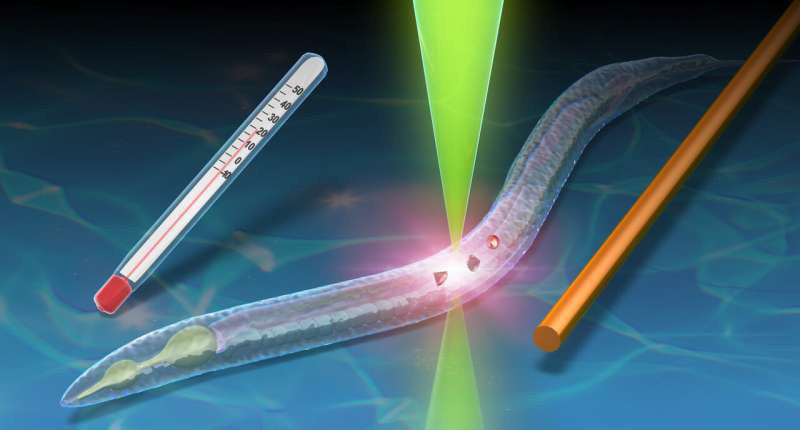Temperature of C. elegans measured via tracking of embedded nanodiamonds. Credit: Masazumi Fujiwara, Osaka City University
A team from Osaka City University, in collaboration with other international partners, has demonstrated a reliable, precise, microscope-based thermometer using quantum technology that measures the temperature fo microscopic animals. The technology detects temperature-dependent properties of quantum spins in fluorescent nanodiamonds.
The research is published in Science Advances.
The optical microscope is one of the most basic tools for analysis in biology, using visible light to to observe microscopic structures directly. In the modern laboratory, fluorescence microscopy, an enhanced version of optical microscopy using fluorescent biomarkers, is now more widespread. Recent advancements in fluorescence microscopy have allowed for live imaging of the details of a structure, and through this, obtaining various physiological parameters in these structures, such as pH, reactive oxygen species and temperature.
Quantum sensing is a technology that exploits the ultimate sensitivity of fragile quantum systems to the surrounding environment. High-contrast MRIs are examples of quantum spins in fluorescent diamonds and are some of the most advanced quantum systems working at the forefront of real-world applications. Applications of this technique to thermal biology were introduced seven years ago to quantify temperatures inside cultured cells. However, they had yet to be applied to dynamic biological systems where heat and temperature are more actively involved in biological processes.
The research team decorated the surface of the nanodiamonds with polymer structures and injected them to C. elegans nematode worms, one of the most popular model animals in biology. The researchers sought to learn the base healthy temperature of the worms. Once inside, the nanodiamonds moved quickly, but the team's novel quantum thermometry algorithm successfully tracked them and steadily measured the temperature. The researchers induced a fever within the worms by stimulating their mitochondria with a pharmacological treatment. The team's quantum thermometer successfully observed a temperature increase in the worms.
"It was fascinating to see quantum technology work so well in live animals, and I never imagined the temperature of tiny worms less than 1 mm in size could deviate from the norm and develop into a fever," said Masazumi Fujiwara, a lecturer at the Department of Science at Osaka City University. "Our results are an important milestone that will guide the future direction of quantum sensing as it shows how it contributes to biology,"
More information: "Real-time nanodiamond thermometry probing in vivo thermogenic responses" Science Advances (2020). DOI: 10.1126/sciadv.aba9636
Journal information: Science Advances
Provided by Osaka City University
























